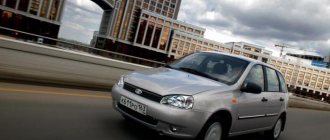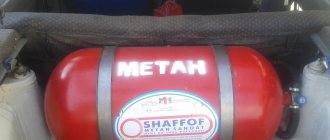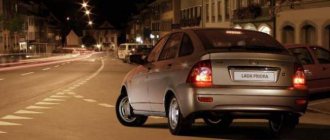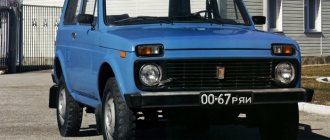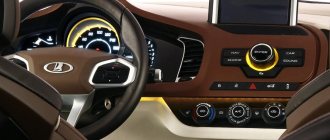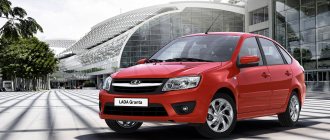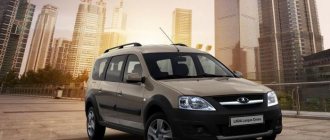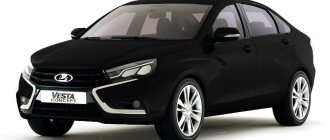Cars admin26.02.2020
From the start of production, the “Dvoyka” managed to fall in love with motorists due to its utilitarianism and laconic design, but time passed and it needed a successor - one that could retain the best qualities of its predecessor, but at the same time more modern and functional. This is how the fourth series model appeared.
The history of the model begins in 1984. The VAZ 2104 became a logical continuation of the 2102, and the latter lasted on the assembly line after the launch of the Four until 1985.
The Lada 2104 differs from its ideological predecessor in a more modern design, but it is designed on the basis of the 2105. Therefore, the front part of the body is almost completely unified with the donor model.
In particular, the headlight optics are made rectangular, and the metal bumper has plastic covers. The roof has stampings for attaching an additional luggage rack. The fifth door opens upward and is equipped with a windshield wiper.
The interior received an informative instrument panel. The center console has become more spacious and functional. As useful innovations, it is worth noting the presence of an electric heated rear window, the presence of headrests in the front seats, and a more comfortable steering wheel.
Over all the years of production, the Lada 2104 has received many variations that have different technical characteristics.
But the following modifications are common on the Russian market:
- 2104. This Zhiguli is equipped with a 1.3 liter engine with a return of 64 horsepower.
- 21043. The car is driven by a 1.5 liter engine that produces 75 horsepower.
- 21041i. Under the hood is a 1.6-liter injection engine with a capacity of 74 “horses”.
- 21044. A distinctive feature of this version is the 1.7-liter power unit, developing 79 horsepower.
The Four was equipped with a four- and five-speed manual transmission. Drive - only to the rear axle.
What is the opinion of the owners?
Lada 2104 attracts with its high utilitarianism, which ensures good demand for it. Owners value high practicality and high-torque engines, but reliability raises questions among many. Reviews say that the main weakness of the model is its poor corrosion resistance.
Tuning the “Four” is widespread. The changes concern the styling of the station wagon, as well as improving interior amenities.
In order to increase the traction performance of engines, owners bore the cylinders and install a more efficient carburetor. More detailed information about the modifications to the machine is contained in the videos, which can be found on the Internet.
VAZ-2104 Tank volume, trunk Load capacity Fuel consumption
Since the end of 1984, this five-seater station wagon with a classic layout, belonging to the second generation of the “classics,” replaced the “first” generation station wagon, the VAZ-2102, on the assembly line, but they were produced together for another year. The Zhiguli station wagon VAZ-2104 remains the most popular domestic small utility vehicle.
Price policy
How much does a Russian station wagon cost on the secondary market? The price tag varies depending on the technical condition and year of manufacture.
| Automobile | Cost (rubles) |
| VAZ 2104 | from 10 to 250 thousand |
Tribute to tradition
Despite the fact that the Lada 2104 is a more modern analogue of the 2102 model, the overall dimensions of the body, as well as its proportions, have been preserved. And, that's not a bad thing. The Russian station wagon still looks harmonious and even swift. In addition, rectangular lights visually expand the front part of the body.
Nothing extra
Compared to the VAZ 2102, the Four's interior looks more laconic, but at the same time more functional. The instrument panel with tachometer is quite informative. The indicator lamps are not dispersed throughout the dashboard, but are arranged in a row in its center, which makes them easier to read.
The climate system is located on the dashboard - it is regulated by sliders. The center console is made voluminous, which not only has a positive effect on the overall design of the front panel, but also allows you to place small luggage in it.
The front seats are not devoid of profile, which makes long trips relatively comfortable. The width of the rear sofa can accommodate three people, but there is very little space for knees. The trunk size in its original state cannot be called outstanding - 345 liters, but the volume can be increased to 1 cubic meter by folding the rear sofa.
Minimum Required
The most modern in the power range is the 1.6 liter engine with an injection system. Its 74 forces are quite enough to move relatively quickly in the city.
Technical characteristics of the car
The most noticeable changes in the VAZ 21043 were those related to engine replacement, as evidenced by the instruction manual:
- speed increased by 2 km/h, to 145 km/h;
- fuel consumption has increased slightly: in the urban cycle, 2104 spends 9.9 liters of AI-92 gasoline per 100 km, and 21043 - 10.2 liters of fuel of the same brand;
- acceleration to 100 km/h remains almost unchanged.
Externally, the 4th and 43rd modifications are practically indistinguishable. A heating device and a wiper on the glass of the rear door have appeared, but a specialist will reasonably argue that the 2104 models have long been equipped with these options in the export configuration.
It’s not uncommon to see a car on the road that differs from the 21043 in its “seven” interior or radiator front. It happens that a different instrument panel is installed. Popularly the name VAZ 21047 was assigned to this car, which is incorrect. The index 21047 means a modification with right-hand drive, intended for export. A station wagon with an interior from the “Seven” is designated VAZ 21043-20.
We are drivers
Let’s not lie - the “classic” is not a competitor to the “ten” in terms of handling, even to the station wagon. But even with the archaic suspension of the Zhiguli, it is possible to achieve acceptable behavior of the car on the road, if everything in it is functional and properly configured.
When two cars drive behind each other in the same mode, you notice the first strange thing in the behavior of the “four” – the setting of its shock absorbers. Contrary to modern ideas about controllability, they begin to work only when the wheels move quickly. No - they react to hitting potholes or strong body rolls in turns, but the subtle movements of the steering wheel, which the driver usually uses to keep the car on a given path, are almost completely ignored.
Undoubtedly, the lack of a clear response to subtle control inputs is a problem not only with shock absorbers. Play in the steering, even small, contributes. It can also be treated by timely adjustment of the steering mechanism and installation of a less pliable pendulum lever. These are sold in stores and are even in demand, but, as far as we know, they do not end up on the production line.
Let's not forget the silent blocks - the performance of the suspension directly depends on their condition and quality. Try asking the salesperson at a car dealership which ones are “the best”. An honest person will first answer you that there are no “best” ones, and only then will he begin to recommend something.
Are we getting carried away? Sorry. Please do not judge strictly - I am ready to explain the reason for this lyrical digression. One of our colleagues (a person with extensive experience) was shocked by the controllability of the “four” that came to us for testing. Since he had his own “classic”, it turns out that a lot has changed in these cars. And not for the better. What is the “eleventh”?
It’s annoying in a new car, especially not the cheapest one, to hear crickets in the right door and the constant creaking of the rear parcel shelf. The adjustment range of the right mirror was too small or too biased towards the driver. In the extreme “far” position, the starboard side is clearly visible in the mirror, and in order to assess whether it is possible to change lanes to the right, you have to lean your whole body.
The design features of the car are such that its response to turning the steering wheel depends too much on the speed of the maneuver. A small amplitude, but fast movement of the steering wheel when going around an obstacle here reaches the wheels with a great delay or does not reach it at all - as if it is stuck somewhere.
In general, the “eleventh” is more strict and precise in control, less lax and not so “independent”. Landing in it is much more comfortable. However, let's say a kind word about the Quartet. For example, on a bad road you don’t feel so sorry for it – against the general noise background, the suspension doesn’t seem to “thump” much. And also, with the kind of mirrors that the dealer installed on our car, visibility became simply excellent (when will the factory bother about this?).
Chassis
The suspension here is completely identical to the “five”. So, the front has an independent suspension with hydraulic shock absorbers and transverse swing arms. There was a bridge at the back and there were rods (four longitudinal and one transverse). Brakes are discs at the front and drums at the rear. As reviews note, this car lacks brakes, especially if it is loaded with 200-300 kilograms. There are also complaints about the steering. The car has poor road holding and is not maneuverable.
Among the advantages of the suspension is its softness. However, this does not mean that you can safely “fly” through the pits. The suspension doesn't like sharp impacts. Because of this, the shock absorbers leak and the lower arms are deformed. Among the weak points of the Zhiguli suspension, it is worth noting the ball joints. These are supports and tips. They become unusable very quickly. Wheel bearings also have a short lifespan. Another drawback is the sound of the suspension. Even if the chassis is in good working order, various knocks can be heard inside. It's alarming at first, but you can get used to it.
Delivery of goods to the population
The fifth door of the “ten” is probably its most unfortunate place. On our sample, it closed only after three to five strong claps, and sometimes it opened only after the second press of the remote trunk release button. Do you think it can be adjusted and used for health? Does not work. From the experience of using other VAZ-2111s, we know that adjusting the fifth door lock can alleviate the suffering of this body part (and the owner of the car), but not eliminate it.
And also, I’ll tell you a secret, the author did not have enough strength to recline the right (smaller) part of the rear seat back in the same “eleventh”. A stronger (about 130 kilograms) comrade helped. So that I wouldn’t get upset, he explained that the point was that I didn’t have a solid skill. They say, I don’t know in which direction it needs to be rocked, but he knows. True, he still agreed that cars couldn’t be made that way.
In the “four”, everything is in order with the fifth door, and the seat folds easily. Just to fold the backrest alone, you will have to walk twice from its right latch to the left. If we take for granted the continuous backrest of the rear seat, the VAZ-2104 still wins as a truck. But it’s worth picking up a tape measure.
The distance from the trunk floor to the shelf in the “eleventh” is 50 cm, in the “four” – only 40. From the fifth door to the folded seat, respectively, 160 and 145 cm. The maximum size of the luggage compartment diagonally on the floor is 200 and 180. In general, no matter where you place the tape measure, you will find more in the station wagon of the “tenth” family. We even decided to determine the maximum size of the cabin diagonally and from bottom to top, as if we were going to drive a lining. And here 2111 has an advantage - 280 cm versus 270.
So that the “four” would not be upset, they were awarded a consolation prize - for the utilitarian nature of the finishing materials. That is, the “eleventh” has a nice velor on the trunk floor, while the VAZ-2104 has washable plastic. If, while fulfilling your “universal” duty, your car gets dirty, you can wash it quickly and cheaply. By the way, who do you think, besides the owner, is capable of truly “doing” the car.
History [edit | edit code]
Serial production of the VAZ-2104
(“fours”) was launched at the Volzhsky Automobile Plant in the second half of 1984. In parallel with the new model, a similar class car, the VAZ-2102 (“two”), was produced, which by April 1985 was completely forced out of the assembly line. The “four” received a number of original parts relating to the rear of the car from the “donor” car.
When creating this model, the designers were guided by an important feature of that time: the creation of a new model with minimal production costs and maximum consumer effect. Therefore, the VAZ-2105 model was taken as a basis. After lengthening the roof, stampings appeared to increase rigidity. This body design allows you to place a long trunk on the roof, which is not recommended to be overloaded, since the design rigidity of the station wagon body is significantly lower than that of a sedan. The rear door opened upwards, and a completely new solution was used - a heated rear window and a windshield wiper - which until 1994 was used only in the production of cars for export, and then became standard.
At the end of the 1990s, an “improved” modification of the VAZ-21043-20
, equipped with a five-speed gearbox, roof rails, electrical equipment and an interior with anatomical front seats from the VAZ-2107, erroneously referred to for marketing purposes as
VAZ-21047
. In fact, this index is carried by the version for countries with left-hand traffic and a 1.45 liter engine.
Salon [edit | edit code]
The interior for the new model was borrowed from the base model, with the exception of the rear seat. The folding rear seat allows you to increase the volume of the luggage compartment from 375 to 1340 liters, and then you can transport large cargo. The total vehicle load has increased to 455 kg. In the basic configuration, the interior trim is quite simple. The Spartan version assumes a standard panel with a minimum required set of instruments, upholstery and seats with standard removable faux leather headrests and rubber floor mats. The desire for greater comfort is proposed to be satisfied with improved seat upholstery made of brushed jersey, solid-molded door linings, brushed floor mats, an instrument panel with an additional center console, which has an expanded set of function keys and control equipment, and an original steering wheel.
Like God a turtle
Assembling cars can truly work wonders - both literally and figuratively. In direct terms, this is when, communicating, for example, with a simple Matiz, you cannot understand why you like it. Miracles in a figurative sense - on the contrary, when, having driven a modern domestic car, which has a good maximum speed, low fuel consumption, and the climate is controlled by an SAUO computer, you still want to call it Soviet.
And yet the greatest miracles await in a car built to be cheap. You lift the trunk floor covering and stains of rust are visible on the fresh paint that still smells like a conveyor belt. You open the driver's door and see a deep mark on the center pillar that some screw at the end of the door has torn through the metal. When you hang the car on a lift, you immediately see what’s in it. There are drops of antifreeze on the stabilizer mount, and oil drops on the clutch housing. Here is a black spot on the resonator tube - this is the “cut” of the exhaust. Here the muffler bracket hits the body.
The reader decided that we clearly sympathize with the VAZ-2111 - it didn’t happen at all! The copy we received had great difficulty in engaging first gear, and reluctantly in second and third. One of the possible reasons is carelessly assembled rods between the gearbox and the gearshift lever. At least, an inspection in the pit showed that their connecting clamps were bent, and the reaction rod was generally hanging out in the front bracket.
Development of the idea of station wagons at AvtoVAZ
Having launched the VAZ-2104 into production in 1984, AvtoVAZ designers did not remove the drawing paper from their drawing boards. They continued to develop the idea of a station wagon, developing variations of the flagship modification of the VAZ 21043. Over the years of production of the 43rd model, they were tested:
- 21048 - diesel VAZ-343, 1.77 liters;
- 21041i - 1.6-liter VAZ-21067 injection engine;
- 21041 VF - injection VAZ-2103 1.5 liters.
These modifications were not produced en masse, but all these years they kept domestic designers in relative shape.
Having exhausted the potential of the body in twenty years of production, and the potential of the engine in thirty years, modification 21043 left the production line. But the objective advantages of station wagons have not gone away. New groups of layout adherents have emerged. These are city dwellers with large families and young people who value the ability to transport large sports equipment.
Station wagons are strengthening their position in the market. And AvtoVAZ is the leader in this. Recently, the Lada Largus station wagon has become popular. This car, like the VAZ 2104 in its time, has a European prototype - the Dacia Logan MCV model produced by Renaul-Nissan. Lada Largus is available in both 5-seater and 7-seater versions, which expands its capabilities. Largus engines have been tested on Renault Logan and have excellent technical characteristics. The spare wheel under the bottom reduces the ground clearance, but the promising Lada Largus Cross does not have this drawback.
Domestic heirs of the legendary VAZ 21043 station wagon are still leaders in our market, now competing not only with the two-volume Moskvich-2141, but also with the KIA Ceed and Ford Focus station wagons.
| LADA 2104 | |
| Total information | |
| Manufacturer | VAZ |
| Years of production | 1984—2012 [1] |
| Assembly | VAZ (Tolyatti, USSR) AvtoVAZ (Tolyatti, Russia) IzhAvto (Izhevsk, Russia) RosLada (Syzran, Russia) LuAZ (Lutsk, Ukraine) KrASZ (Kremenchug, Ukraine) AntoRus (Kherson, Ukraine) Suzuki Egypt (Giza, Egypt) |
| Class | small group III |
| Other designations | VAZ-2104 "Zhiguli", Lada Estate, Lada Riva Break, Lada Nova Combi |
| Design | |
| Body type | 5-door station wagon (5-seater) |
| Platform | Fiat 124 |
| Layout | front-engine, rear-wheel drive |
| Wheel formula | 4 × 2 |
| Engine | |
| VAZ-2103 | |
| Manufacturer | AvtoVAZ |
| Brand | VAZ-2103 |
| Type | gasoline (AI-92) carburetor |
| Volume | 1,458 cm 3 |
| Maximum power | 52.5 kW (71 hp), at 5600 rpm |
| Maximum torque | 104 Nm, at 3400 rpm |
| Configuration | in-line, 4-cylinder. |
| Cylinders | 4 |
| Valves | 8 |
| Combined fuel consumption | 9,9 |
| Fuel consumption in the urban cycle | 9,8 |
| Fuel consumption on the highway | 7,0 |
| Environmental standards | Euro 2 |
| Compression ratio | 8,5 |
| VAZ-2105 | |
| Manufacturer | AvtoVAZ |
| Brand | VAZ-2105 |
| Type | gasoline (AI-92) carburetor |
| Volume | 1,290 cm 3 |
| Maximum power | 46.80 kW (64 hp), at 5600 rpm |
| Maximum torque | 92.0 Nm, at 3400 rpm |
| Configuration | in-line, 4-cylinder. |
| Cylinders | 4 |
| Valves | 8 |
| Combined fuel consumption | 9,2 |
| Fuel consumption in the urban cycle | 10 |
| Fuel consumption on the highway | 6,9 |
| Environmental standards | Euro 2 |
| Compression ratio | 8,5 |
| VAZ-21067 | |
| Manufacturer | AvtoVAZ |
| Brand | VAZ-21067 |
| Type | gasoline (AI-92) distributed injection |
| Volume | 1569 cm 3 |
| Maximum power | 55 kW (75 hp), at 5000 rpm |
| Maximum torque | 116.0 Nm, at 3400 rpm |
| Configuration | in-line, 4-cylinder. |
| Cylinders | 4 |
| Valves | 8 |
| Combined fuel consumption | 8,5 |
| Fuel consumption in the urban cycle | 11,3 |
| Fuel consumption on the highway | 6,9 |
| Environmental standards | Euro 2 |
| Compression ratio | 8,5 |
Which one do we take?
Of course, the “eleventh” is a cut above, but, realizing that the VAZ-2104 took part in an obviously unequal battle, I will allow myself a few “IFs”.
If, when using a VAZ-2111 as a delivery vehicle, you have to slam the back door ten times a day to close it, someday it will completely bore you.
If, during the same official use, you load anything into the velor-covered trunk of the “eleventh”, you will be tormented with dry cleaning.
If a private owner, who is ready to load the “barn” to the roof with potatoes and tomatoes, sometimes hits the curbs with his sagging backside, he will ruin himself by repairing the “tenth” bumper.
And one more, final “IF”. If the car manufacturer intends to continue to think about the consumer as unflatteringly as the consumer thinks about him, and just like the consumer, to live in hope of a model from a bright future, he will get to this very future alone. Without a consumer.
Author: Alexander Budkin
There is a long-awaited addition to the small regiment of domestic station wagons - IZH-Fabula has entered service, standing shoulder to shoulder with the VAZ 2104. It is not difficult to guess that the new product is designed to become more attractive than the long-familiar one. Behind the wheel
Overall dimensions of VAZ 2104 cars. Detailed data on the length, height and width of Lada (VAZ) 2104 cars, depending on the modification and year of manufacture. Standard ground clearance (clearance) of Lada (VAZ) 2104 cars.
Select the model and modification below:
| Modification | Length | Width | Height | Ground clearance |
| 2104 / 2104 1.3 MT (64 hp) (1984) | 4115 mm | 1620 mm | 1443 mm | 170 mm |
| 2104 / 21041i 1.6 MT (74 hp) (2000) | 4115 mm | 1620 mm | 1443 mm | 170 mm |
| 2104 / 21043 1.5 MT (75 HP) 4MT (1984) | 4115 mm | 1620 mm | 1443 mm | 170 mm |
| 2104 / 21043 1.5 MT (75 HP) 5MT (1984) | 4115 mm | 1620 mm | 1443 mm | 170 mm |
| 2104 / 21044 1.7 MT (79 hp) (1997) | 4115 mm | 1620 mm | 1443 mm | 170 mm |
| 2104 / 21045 1.5d MT (53 hp) (1999) | 4115 mm | 1620 mm | 1443 mm | 170 mm |
| 2104 / 21047 1.5 MT (75 hp) (1998) | 4115 mm | 1620 mm | 1443 mm | 170 mm |
Owner reviews:
Place in the lineup
In the silhouette of the popular station wagon VAZ 2104, the contours of its prototypes are easily read - the domestic VAZ 2102 and the Italian Fiat 124 Familiare. These contours are modest and laconic, but stylish and modern. It’s not for nothing that the “four” have become so tightly integrated into the market. From 1984 to 2012, it rolled off the production lines of seven companies, including AvtoVAZ and IzhAvto. The “four” ousted its domestic predecessor from production within a year, and outlived the Italian by two decades.
Having decided to update the model of the first generation rear-wheel drive station wagon, AvtoVAZ designers did not look for good from good. The body of the popular VAZ 2105 sedan was made two-volume, supplemented with parts from the VAZ 2102. The result was model 2104. The model looked fresh and retained all the functional advantages of its predecessors, such as a low loading height and the absence of a rear side in the luggage compartment.
The only objection that the market expressed concerned the engine power. Driving with a large cargo compartment filled to capacity required a more powerful power unit. “Fours” were often used for cargo and passenger transportation, including off-road, and the issue of engine power was very relevant.
The answer to this market challenge was the VAZ 21043 model. This time, the designers were also not particularly clever. The station wagon was equipped with a more powerful engine, which has proven itself in terms of the ability to repair it, with a VAZ 2103 carburetor engine with a displacement of 1.5 liters.
The car turned out to be a sight to behold. Optimal in terms of “functionality/comfort” ratio, it made it possible to take the wife to the general store and feed to the farm. Balanced in terms of power/efficiency ratio, the car confidently accelerated and maneuvered with a full load.
Skoda Kodiaq
Good afternoon! I am writing my personal opinion about the Skoda Kodiaq, on which I have already driven more than 27 thousand km. So.
Dealer news:
New cars and used cars - tens of thousands of ads for sale. Reviews from car owners. Technical characteristics and accessories. Comparison of models and Test Drives. News from the world of cars. Prices for new cars. Promotions and special offers from car dealerships. We will help you make your choice!
This site is for informational and reference purposes only and under no circumstances constitutes a public offer.
Certificate of registration of mass media EL No. FS77-68106 dated December 21, 2016. Issued by the Federal Service for Supervision of Communications, Information Technologies and Mass Communications. 16+
Design features [edit | edit code]
Since the front part of the car is identical to models with a sedan body, it is more difficult for a standard heater to warm a larger volume of the interior during the cold season. The back of the car often fogs up in cold weather. The car normally does not have rear ventilation holes for venting interior air (unlike the VAZ-2107), which makes it difficult to close the doors (with the windows closed). Compared to the VAZ-2105, 2107 (with identical engine installations), it has a lower maximum speed (data from the “operating instructions”
142 km/h) due to the changed final drive ratio - 4.44 (early modifications) versus 4.3 on the sedan. The rear door is subject to contamination by road dirt (dust raised by wheels), which is locally drawn when driving at high speeds into the low-pressure zone - this is corrected by installing an upper deflector on the 5th door, supplying (to the low-pressure zone) cleaner air from the roof. There is also a way to avoid the accumulation of dirt on the back door - this is to change the design of the rear bumper - the lower part must be bent in the opposite direction and the gap between the bumper and the body must be closed - a plate 1 meter by 15 cm in the middle. The gas tank with a volume of 43 liters (versus 39) is located horizontally under the bottom of the trunk without additional protection - there is a risk of damage when driving over rough terrain.
Dimensions, weight, ground clearance and trunk volume of VAZ (Lada) 2104 Station wagon 2104 MT (64 hp)
| Length, mm | 4115 |
| Width, mm | 1620 |
| Height, mm | 1443 |
| Wheelbase, mm | 2424 |
| Front track, mm | 1365 |
| Rear track, mm | 1321 |
| Turning diameter, m | |
| Load on front/rear axle, kg | |
| Number of seats in the cabin | 5 |
| Loading height, mm | |
| Curb weight, kg | 1020 |
| Cargo compartment (length x width x height), mm | |
| Ground clearance/clearance, mm | 170 |
| Maximum trunk volume, l | 1035 |
| Minimum trunk volume, l | 345 |
| Cargo compartment volume, m3 | |
| Total weight, kg | 1475 |
| Load capacity, kg | 455 |
Notes
- Until 2003, it was produced at AvtoVAZ, then production was transferred to the IzhAvto conveyor. In addition, at the RosLada plant in Syzran, production of the VAZ-2104 with diesel engines began, but it was soon curtailed. IzhAvto produced the “four” in various configurations from 2003 to 2009 (source: “Autolegends of the USSR” magazine), then production was stopped due to financial difficulties. However, since September 2010, the plant resumed production of the LADA 2104. Production of the car at IzhAvto ceased on September 17, 2012
- The maximum permitted weight is indicated in brackets, and the curb weight is indicated outside the brackets.
- IzhAvto completes production of Lada 2104
- O. Gordeeva.
The diesel “four” with 1.8 will appear in two years
(unspecified)
. ZR (April 25, 2003). - Diesel "five" (undefined)
.
Wheel
. ZR (No. 10, 2003). - You drive more quietly, you smell of diesel fuel... (unspecified)
(inaccessible link). ZR (No. 4, April 2000). Access date: October 19, 2015. Archived March 5, 2016.
